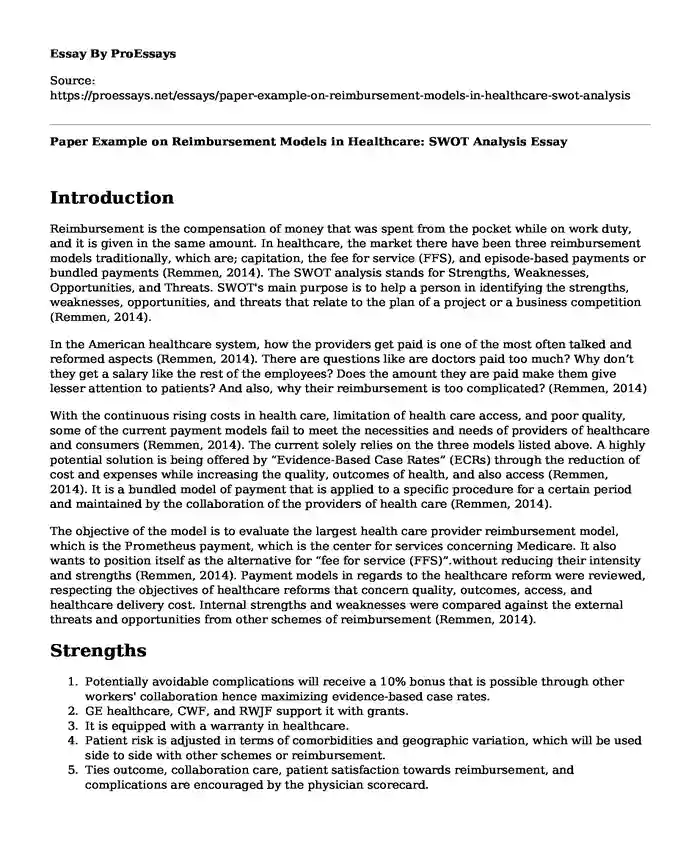Introduction
Reimbursement is the compensation of money that was spent from the pocket while on work duty, and it is given in the same amount. In healthcare, the market there have been three reimbursement models traditionally, which are; capitation, the fee for service (FFS), and episode-based payments or bundled payments (Remmen, 2014). The SWOT analysis stands for Strengths, Weaknesses, Opportunities, and Threats. SWOT's main purpose is to help a person in identifying the strengths, weaknesses, opportunities, and threats that relate to the plan of a project or a business competition (Remmen, 2014).
In the American healthcare system, how the providers get paid is one of the most often talked and reformed aspects (Remmen, 2014). There are questions like are doctors paid too much? Why don’t they get a salary like the rest of the employees? Does the amount they are paid make them give lesser attention to patients? And also, why their reimbursement is too complicated? (Remmen, 2014)
With the continuous rising costs in health care, limitation of health care access, and poor quality, some of the current payment models fail to meet the necessities and needs of providers of healthcare and consumers (Remmen, 2014). The current solely relies on the three models listed above. A highly potential solution is being offered by “Evidence-Based Case Rates” (ECRs) through the reduction of cost and expenses while increasing the quality, outcomes of health, and also access (Remmen, 2014). It is a bundled model of payment that is applied to a specific procedure for a certain period and maintained by the collaboration of the providers of health care (Remmen, 2014).
The objective of the model is to evaluate the largest health care provider reimbursement model, which is the Prometheus payment, which is the center for services concerning Medicare. It also wants to position itself as the alternative for “fee for service (FFS)”.without reducing their intensity and strengths (Remmen, 2014). Payment models in regards to the healthcare reform were reviewed, respecting the objectives of healthcare reforms that concern quality, outcomes, access, and healthcare delivery cost. Internal strengths and weaknesses were compared against the external threats and opportunities from other schemes of reimbursement (Remmen, 2014).
Strengths
- Potentially avoidable complications will receive a 10% bonus that is possible through other workers' collaboration hence maximizing evidence-based case rates.
- GE healthcare, CWF, and RWJF support it with grants.
- It is equipped with a warranty in healthcare.
- Patient risk is adjusted in terms of comorbidities and geographic variation, which will be used side to side with other schemes or reimbursement.
- Ties outcome, collaboration care, patient satisfaction towards reimbursement, and complications are encouraged by the physician scorecard.
Opportunities
- Provider payments are looked at in a new unique and new way.
- Healthcare workers who are segmented are captured
- Methods that measure and make sure that there is appropriate care are developed.
- Physician’s scorecards that can be used by patients will be designed and also publicly promoted.
- Input data and pilot sites will be diversified because they are not always applicable to every geographic location or all populations.
Threats
- The backlash of providers from published scorecards pressure.
- Less resources for small practices and national-level implementation.
- It encourages providers to have negotiations with third parties.
Weaknesses
- Due to the statistic driven models that are too high, it is seen and criticized as complex.
- The concern about introducing a payment model that is very complex which Is seen as replacing an existing complex model with a new of the kind.
- Consensus with best clinical practices is hard to reach, and also the effect timing of chronic disease diagnosis and procedure.
- ECR's accountability is not clear.
- The price of episode care is derived from input data that is obtained from the insured claims database.
References
McGinnis, J. M., Stuckhardt, L., Saunders, R., & Smith, M. (Eds.). (2013). Best care at lower cost: the path to continuously learning health care in America. National Academies Press. https://books.google.com/books?hl=en&lr=&id=_wUw6XCFqGwC&oi=fnd&pg=PR1&dq=McGinnis,+J.+M.,+Stuckhardt,+L.,+Saunders,+R.,+%26+Smith,+M.+(Eds.).+(2013).+Best+care+at+lower+cost:+the+path+to+continuously+learning+health+care+in+America.+National+Academies+Press.&ots=0Krzv7gcso&sig=DDrPSQsc9XB8Y-WGWPkFDuzH-Gg
Van Durme, T., Macq, J., Anthierens, S., Symons, L., Schmitz, O., Paulus, D., ... & Remmen, R. (2014). Stakeholders’ perception on the organization of chronic care: a SWOT analysis to draft avenues for health care reforms. BMC health services research, 14(1), 179. https://link.springer.com/article/10.1186/1472-6963-14-179
Cite this page
Paper Example on Reimbursement Models in Healthcare: SWOT Analysis. (2023, Sep 10). Retrieved from https://proessays.net/essays/paper-example-on-reimbursement-models-in-healthcare-swot-analysis
If you are the original author of this essay and no longer wish to have it published on the ProEssays website, please click below to request its removal:
- Critical Infrastructure Security Emergency Management: An Assessment of Richmond-Virginia International Airport
- Policy Training Plan Paper Example
- Essay on Chronic Fatigue & Chest Pain: Heterogeneous Presentation Requires Patient's Perspective
- Brain-Heart Interdependence: A Deep Connection? - Essay Sample
- Protecting Older Adults During the Covid-19 Pandemic - Essay Sample
- Paper Sample on Highly Stressed: Psychological Stress in People Living with HIV/AIDS in the US South
- Medication Errors: Patient Safety Issue - Research Paper Sample







